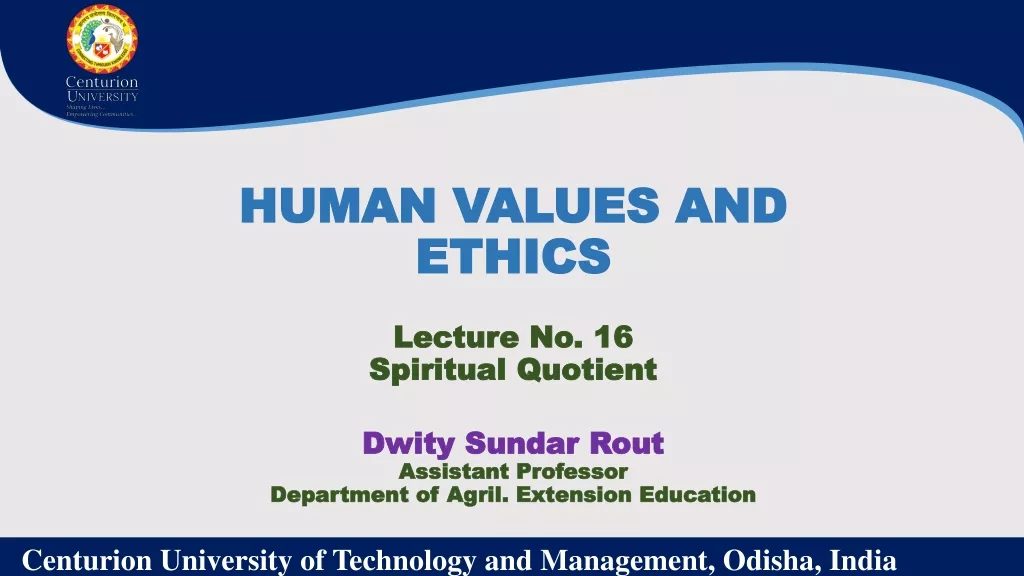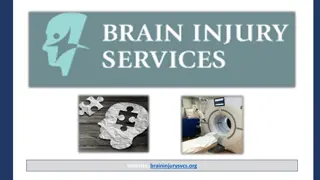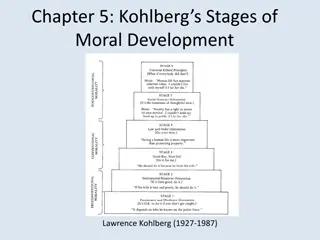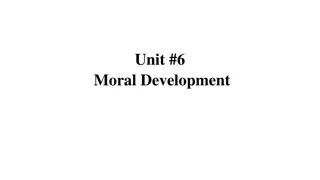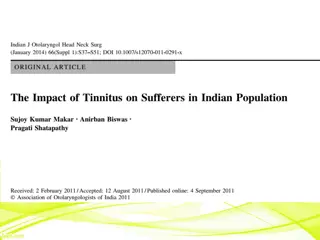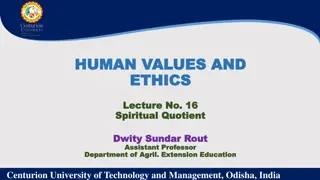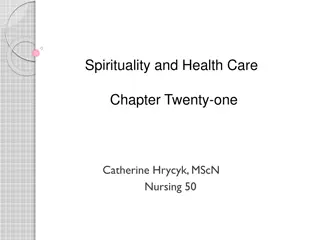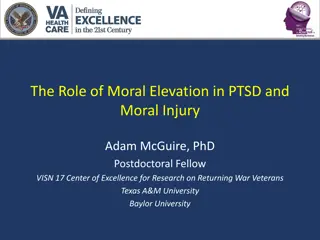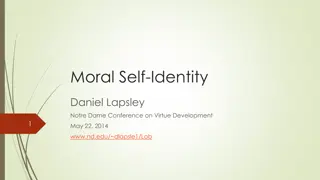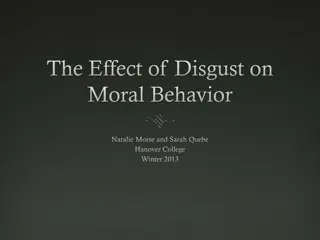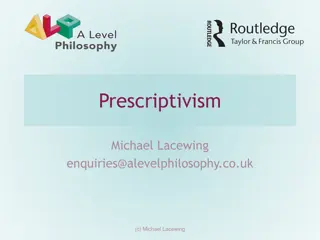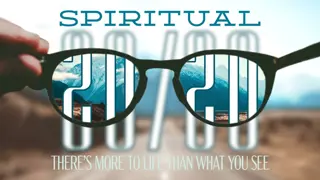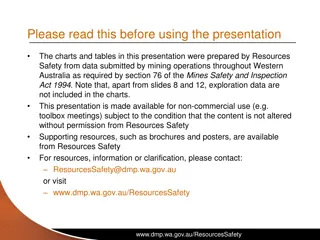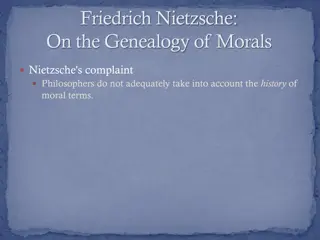
Understanding Moral Injury and Spiritual Distress in Healthcare Settings
Explore the impact of moral injury and spiritual distress on individuals in healthcare, focusing on the role of chaplains in providing support. Learn about definitions, examples, signs, and interventions to address moral and spiritual challenges. Gain insights into the overlap with PTSD and trauma-related disorders.
Download Presentation

Please find below an Image/Link to download the presentation.
The content on the website is provided AS IS for your information and personal use only. It may not be sold, licensed, or shared on other websites without obtaining consent from the author. If you encounter any issues during the download, it is possible that the publisher has removed the file from their server.
You are allowed to download the files provided on this website for personal or commercial use, subject to the condition that they are used lawfully. All files are the property of their respective owners.
The content on the website is provided AS IS for your information and personal use only. It may not be sold, licensed, or shared on other websites without obtaining consent from the author.
E N D
Presentation Transcript
Moral Injury/Spiritual Distress: Moral Injury/Spiritual Distress: A Scoping Study A Scoping Study Spiritual Spiritual Care Care Research Research VA VA NYHHS Chaplain Residency Program NYHHS Chaplain Residency Program 12 July 2017 12 July 2017 Team: Chaplain Residents Courtney Ducharme, Team: Chaplain Residents Courtney Ducharme, David Ani, Ahmet Atlig, Richard Mattox, Stacy Sokol David Ani, Ahmet Atlig, Richard Mattox, Stacy Sokol CPE Supervisor: Chaplain Andrew Sioleti, IV Dei, LCSW, D.Min, Chief of Chaplains, VA NYHHS, ACPE Certified Educator Research Instructor: Chaplain Fellow John Schultz Research Mentor: Dr. Jeanette Irene Harris, VA Minneapolis MN Subject Matter Expert Consultants: Dr. Joseph Currier, University of South Alabama Dr. Marek S. Kopacz, VA Canandaigua, NY Dr. Brett T. Litz, Boston University, Massachusetts Veterans Epidemiological Research and Information Center Library Technician: Mr. Eric Hellman This material is based upon work supported (or supported in part) by the Department of Veterans Affairs, Veterans Health Administration, Office of Research and Development. The contents of the publication/presentation do not represent the views of the Department of Veterans Affairs or the United States Government. Correspondence concerning this article should be sent to Chaplain Andrew Sioleti, andrew.siolet@va.gov or 212-686-7500, ext. 7371. 2
Focus attention on Moral Distress Moral Injury and Spiritual Distress (MI/SD) Focus upon role of Chaplains and Spiritually- integrated interventions in support of Patients, Families, Caregivers, Loved ones, Doctors, and Nursing Staff suffering from Moral Distress pre-action and Moral Injury or Spiritual Distress post-action We want you to live a life that you are proud of, even as you carry your moral injury. --Portland, Oregon Veterans Administration ACT for Moral Injury Group Program 4 Moral Injury/Spiritual Distress: A Scoping Study
Terms of Reference Definitions of Moral Injury/Spiritual Distress Transgressive Acts or Potentially Morally Injurious Events Moral Injury Around Us: Case Examples Nature and Signs of Moral Injury/Spiritual Distress Places of Expression Conceptual Model Why Spiritual Healing Role of Chaplains and Clergy Spiritual Interventions and Care Practices Spiritual Diagnosis (NCCN) Literature Findings Overlap with PTSD and Trauma or Stressor-Related Disorders in Adults in DSM-5 KIntsugi 5 Moral Injury/Spiritual Distress: A Scoping Study
Moral Injury is not a universally subscribed term Spiritual distress, inner conflict, spiritual injury, combat and operational stress injuries, moral confusion, moral trauma, shattered assumptions, combat and operational stress, soul wound, shell shock, battle fatigue, moral pain, nostalgia, nervous disease, a soldier s heart, combat fatigue, post-trauma syndrome, post-Vietnam syndrome (Antal, 2017; Carey, et al 2016; Dombo et al., 2013, Harris, 2017; Litz et al., 2009; Masick, 2016) 6 Moral Injury/Spiritual Distress: A Scoping Study
Spirituality: a dynamic and intrinsic aspect of humanity through which persons seek ultimate meaning, purpose, and transcendence, and experience relationship to self, family, others, community, society, nature, and the significant or sacred. Spirituality is expressed through beliefs, values, traditions, and practices. (Puchalski, Vitillo, Hull et.al. International Conference on Global Integrating Spirituality into Health, 2013) Morals: personal and shared familial, cultural, societal, Religious and legal rules for social behavior, either tacit or explicit; fundamental assumptions about how things should work and how one should behave in the world. (Litz, 2009) Religiosity: A complex construct of conviction, devotion and veneration toward a divinity and a dedication to the rituals, traditional and theology of a religious faith. These beliefs and practices are often held with considerable emotional intensity and thus are considered sacred (set apart as holy). (Koenig, 2011) 7 Moral Injury/Spiritual Distress: A Scoping Study
Perpetrating, failing to prevent, bearing witness to, or learning about acts that transgress deeply held moral beliefs and expectations. (Litz, et al, 2009) Moral injury is present when (1) there has been a betrayal of what is morally correct; (2) by someone who holds legitimate authority or by one s self; and (3) in a high-stakes situation. All three. (Shay, 2014) Damage done to an individual s core morality or moral worldview as a result of a stressful or traumatic life event. Spiritual distress where damage is done to our relationship with God (the transcendent), self and others and alienates us from that which gives meaning to our lives. (Berg, 1992) Disruption in an individual s confidence and expectations about one s own or others motivation or capacity to behave in a just and ethical manner, brought about by bearing witness to perceived immoral acts, failure to stop such actions, or perpetration of immoral acts, in particular acts that are inhuman, cruel, depraved, or violent, bringing about pain, suffering, or death of others. (Drescher et al., 2011) MI is spiritual disequilibrium. It is the wound received when one s belief system or expectations have been transgressed within a military context. (Lee, 2017) Trauma characterized by guilt, existential crisis and loss of trust that may develop following a perceived moral violation. (Jinkerson, 2016) Moral Injury/Spiritual Distress: A Scoping Study (Yan, 2016) 8
Shame Guilt Anger Outrage Loss of trust Spiritual Crisis Self-punishment Moral disgust Moral Injury/Spiritual Distress: A Scoping Study 9
Acts of betrayal or perceived by peers, leaders, or self (Drescher et al., 2011, Jinkerson, 2016) Disproportionate violence inflicted on others (Drescher et al., 2011, Jinkerson, 2016) Death or harm to civilians (Jinkerson, 2016 also cites Grossman, 2009; Maguen & Litz, 2012; Nash & Litz, 2013; Shay, 2003) Violence within military ranks (Jinkerson 2016) Concealed acts of cowardice, failure to do duty Exposure to body parts Inability to prevent death or suffering (Drescher, et al, 2011; Litz, et al., 2009; Nash & Litz, 2013; Stein, et al., 2012; Vargas et al., 2013) 10 Moral Injury/Spiritual Distress: A Scoping Study
Larisas Reluctant Choice To satisfy her husband and maintain her marriage, Larisa chose to end a pregnancy against her own desire to carry it to term. She ruminated on memories of the day of the procedure, and on her fears about what the future held for her. ( (Dombo E 2013) Susan s Unholy Affair Susan, a 45-year-old Pastor of a Church. Though a moral leader herself preaching the sanctity of marriage and sin of adultery, Susan violated her marriage vows and moral authority by engaging in a highly sexual affair with another man. ( (Dombo E 2013) Mark s Fatal Trip Home A superstar in both high school and college for his academic achievements as well as athletic achievements. In the seeming invincibility of youth, Mark drove home late at night and very tired. His falling asleep at the wheel resulted in the death of another. ( (Dombo E 2013) Nurses Witnessing Medically Futile Care Assigned to work with physicians who are not as competent as patient care requires. Not being able to offer treatment because the costs will not be covered by the insurance company. Increase the dose of intravenous morphine for an unconscious patient and nurse believes it will hasten patient s death. Follow physician s order not to tell the patient the truth when he/she asks for it. (Elpern 2005) Moral Injury/Spiritual Distress: A Scoping Study 11
Rape They left her without clothes beaten and bruised next to the dumpster, she had to walk back naked. They told her you slave you don t belong in this neighborhood . I now feel dehumanized. (Miller 2009) Train Engineer The engineer spotted someone on the tracks staring right up at him making close eye contact, he leaned on the horn and threw on the emergency brakes, it was impossible to avert tragedy. Body parts flew all over and a 40 year old man was dead on the tracks. It was a difference of whether he was going to hit him at 70 miles an hour or hit him at 50 miles an hour. Chaplain Catch-22 Patient threatened Chaplain stating I have suicidal ideation if you don t provide me with such and such I will complete it and it will be on your shoulders . Two days later Patient was found dead at the bottom of an elevator shaft. Chaplain feels things could have been done differently. Hurricane Harvey Twenty-five-year-old Alex was on a mission to check on his beloved older sister's cat when he stepped on a live electrical wire in ankle-deep water. Alex then fell into the lamppost attached to the live wire. Alex s friend moved closer to help, but Alex warned him away. Don't touch me. I'm dying He said. Alex s friend was forced to sit and watch helplessly as his friends body shut down and went limp. Moral Injury/Spiritual Distress: A Scoping Study 12
Spiritual, biological, psychological, & social elements (Litz, et al, 2009; Drescher, et al, 2011) Potential results of transgressive acts or traumatic events both within and outside ROE (Jinkerson, 2016; Harris, 2017, Maguen, et al, 2017) These wounds have no quick fix MI/SD can be individual and communal (Muldoon, 2012) Time/place continuum and disconnect (Haynes, 2017 quoting Ronnie Janoff-Bulman, Shattered Assumptions: Toward an Understanding of Trauma, Presentation to VA Chaplains, April 9, 2013) Combat vs. non-combat context Warrior camaraderie vs. friends & family Self-image Not a diagnosis but a dimensional problem (Maguen & Litz, 2012) No clear thresholds At any particular moment it might be non-extent, mild or extreme (Litz, 2009) 13 Moral Injury/Spiritual Distress: A Scoping Study
Inappropriate guilt and shame Loss of previously held spiritual beliefs or existential issues Struggle or conflict in relationship with Higher Power Questioning morality Difficulty forgiving self, others, or Higher Power Feeling there is no meaning or purpose in life Reduced trust in others Psychological symptoms Social problems Deep demoralization/self-deprecation (Drescher et al., 2011; Shay, 2003) 14 Moral Injury/Spiritual Distress: A Scoping Study
73% of cancer patients expressed at least one spiritual need (Astrow et al, J Clin Onc 2007) 40% of newly diagnosed cancer patients have significant levels of spiritual distress (Holland et al J NCCN, 2010) Illness can raise questions on issues of meaning, purpose, fulfillment. (Puchalski, Ferrel, Viranit et al, JPM 2009)
Chronic Intrusions, Avoidance, Numbing Protective Factors (Belief in a just world; Forgiving Supports; Self-Esteem) Failure to Forgive/ Self- Condem nation Transgression/ Morally Injurious Experience Attributions (Stable, Internal, Global) Shame, Guilt, Anxiety Dissonance/ Conflict Withdrawal Risk Factors (Neuroticism, Shame-proneness) Possibility of enduring changes in self/beliefs becoming ingrained, rigid, resistant to countervailing evidence Self-harming, Self-handicapping, Demoralization 16 Moral Injury/Spiritual Distress: A Scoping Study
Previous studies of spiritually integrated interventions for other types of trauma survivors, have uniformly found positive effects (Cole, 2005; Decker, 2007; Dyer Layer et al., 2004; Harris, 2011; Murray-Swank & Pargament, 2005, 2008) Attractive because military members are more likely to seek spiritual support from Chaplains than from mental health care providers (Becerra & Greenblatt, 1991; Hobfoll, et al, 1991; Tanielian & Jaycox, 2008; Visco, 2009) Can practically focus upon values for living (Drescher, Smith & Foy, 2007) Ideas, beliefs, we hold as good, important and worthy of time and energy Veterans frequently mention valuing: a sense of belonging; self-respect; inner harmony; freedom; family security; health; and enjoying life To what degree our values are reflected in our day-to-day behavior 17 Moral Injury/Spiritual Distress: A Scoping Study
Exercises designed to address concerns about ultimate meaning and purpose relevant to mental health recovery (Pargament, 2007) Military members are more likely to seek spiritual support from Chaplains than from mental health care providers (Becerra & Greenblatt, 1991; Hobfoll, et al, 1991; Tanielian & Jaycox, 2008; Visco, 2009) Practically focused upon values for living (Drescher, Smith & Foy, 2007) Wounds frequently appear well-after the triggering events, are not fixed easily or quickly. (Currier et al., 2015a; Fontana and Rosenheck, 2004; Litz, et al, 2009; Witvliet et al., 2004) 18 Moral Injury/Spiritual Distress: A Scoping Study
Shared spirituality can increase rapport/trust (Borneman, Ferrell, & Puchalski, 2010) Religious crisis associated with increased use of behavioral health services (Fontana & Rosenheck, 2004) Clergy are as likely as a mental health specialist to be sought out (Hohmann & Larson, 1993) Department of Labor statistics: number of hours interfaith clergy engage in pastoral counseling far exceeds the number of hours of treatment recorded by mental health professional members of American Psychiatric Association 19 Moral Injury/Spiritual Distress: A Scoping Study
Specialist in guilt, shame, forgiveness, restoration, community and ritual Moral/ethical authority Representative of the Divine Less stigma Confidentiality Non-judgmental Compassionate Moral Injury/Spiritual Distress: A Scoping Study Patient Non-anxious Engaging in place 20
Active listening and compassionate presence Normalization Making space for mourning Guiding in meaning-making rituals Lament/confession/repentance/making amends Reintegrating into community Exploring pathways and destinations (Pargament, 2007) Observe anniversaries Relationship/family relationships Healing services & healing rituals synched w/ liturgical calendar Refer when necessary 21 Moral Injury/Spiritual Distress: A Scoping Study
Judaism(Sacks, 2014) Repentance-and-forgiveness culture whose central concepts are free will and choice Talmud gives three stages of repentance Admission of guilt Confession Behavioral change that leads to forgiveness Repentance presuppositions We are free and morally responsible agents capable of change Possibility that we are not condemned endlessly to repeat the past future is not predestined Forgiveness Liberates us from the past Breaks the irreversibility of reaction and revenge Undoing of what has been done 22 Moral Injury/Spiritual Distress: A Scoping Study
Christianity Desires reconciliation and restoration of the soldier or veteran to God and full participation in the Christian community (Kinghorn, 2012) Reconciliation calls for (Kinghorn 2012) Patience Eucharist Confession Forgiveness Role of the cross (O Donnell 2015) Kingdom of God: here but not yet (Kinghorn 2012) Spiritual disciplines and the ordinary means of grace (Antal, 2017 cites Foster, 1998) Just War Theory 23 Moral Injury/Spiritual Distress: A Scoping Study
Islam Qur an mentions different levels of moral consciousness of Nafs, ( Self (nafs) in this verse denotes the human personality as a whole, including both the physical body and the soul (ru h)) Negatively inclined state (Qur an 12: 53) Self-reproaching state (Qur an 75: 2) State of inner peace (Qur an 89: 27) The Islamic goal is to purify the self of disjointed and conflicting states thereby attaining and experiencing a unified self through Beliefs - All is from God, both good and evil Intentions - Do God s will Practices Of Gods will To a happy state shall indeed attain he who causes this [self] to grow in purity (Qur an 91: 9 10). The purification process leads to an inner unfolding of something God-like in man reflected in the highest qualities that a person possesses (Nasr, 2000, p. 4). 24 Moral Injury/Spiritual Distress: A Scoping Study
Diagnoses (Primary) Key feature from history Example Statements Lack of meaning / questions meaning about one s own existence / Concern about afterlife / Questions the meaning of suffering / Seeks spiritual assistance My life is meaningless I feel useless Existential Abandonment God or others God has abandoned me No one comes by anymore Lack of love, loneliness / Not being remembered / No Sense of Relatedness Anger at God or others Why would God take my child its not fair Displaces anger toward religious representatives / Inability to Forgive Concerns about relationship with deity I want to have a deeper relationship with God Closeness to God, deepening relationship Verbalizes inner conflicts or questions about beliefs or faith Conflicts between religious beliefs and recommended treatments / Questions moral or ethical implications of therapeutic regimen / Express concern with life/death and/or belief system Conflicted or challenged belief systems I am not sure if God is with me anymore
Spiritual Diagnosis (NCCN Distress Guidelines) Diagnoses (Primary) Key feature from history Example Statements Life is being cut short There is nothing left for me to live for Hopelessness about future health, life Despair as absolute hopelessness, no hope for value in life Despair/ Hopelessness I miss my loved one so much I wish I could run again Grief is the feeling and process associated with a loss of person, health, etc. Grief/loss Guilt is feeling that the person has done something wrong or evil; shame is a feeling that the person is bad or evil I do not deserve to die pain- free Guilt/shame I need to be forgiven for what I did I would like my wife to forgive me Need for forgiveness and/or reconciliation of self or others Reconciliation Since moving to the assisted living I am not able to go to my church anymore Isolation From religious community or other Ritual needs / Unable to practice in usual religious practices Religious specific I just can t pray anymore Loss of faith and/or meaning / Religious or spiritual beliefs and/or community not helping with coping Religious/Spiritual Struggle What if all that I believe is not true
When a service member is: Suicidal Homicidal Needs medicines Becomes disruptive Symptoms don t improve You re at your wit s end Accompany them to: Primary Provider ER/911/Community Mental Health Clinic Veterans Crisis Hotline Moral Injury/Spiritual Distress: A Scoping Study A man s got to know his limitations. --Clint Eastwood as Harry Callahan Magnum Force 27
Trauma Moral Injury PTSD
Research reveals two spiritually-integrated interventions targeting Moral Injury (MI) or Spiritual Distress (SD) with published evidence: Building Spiritual Strength (BSS) and Spiritually-Oriented Cognitive Processing Therapy (SOCPT). These interventions had positive results: BSS in two randomized clinical trials and SOCPT in a qualitative case study. Chaplains with additional mental health training were used as part of the randomized clinical trials. Both plan future randomized clinical trials. (Harris, 2017, Koenig, 2017) Emphasis upon psychosocial perspective may neglect spiritual dimension for both causes and possible alleviations of MI/SD. (Carey 2016, Stallinga 2013) Several psychosocial interventions address PTSD element underlying MI/SD but do not focus upon guilt and shame. (Bomyea 2012, Koenig, 2017,Litz 2017) Despite few evidence-based clinical trials, accomplished SMEs published myriad scholarly literature in peer-reviewed journals recognizing the valuable role of Chaplains and spiritual interventions. (Drescher, 2011; Harris 2017; Koenig, 2017; Nieuwsma 2013) Moral Injury/Spiritual Distress: A Scoping Study 29
MI/SD has historically been an abstract concept in empirical infancy with undetermined applicability in clinical, public health, and research settings. (Kopacz 2014) No agreed upon definition/terminology of MI/SD, Transgressive Acts (TAs)/Potentially Morally Injurious Events (PMIEs). (Litz et al., 2009; Masick 2016; Phelps, 2015; Shay, 2003) As killing has increased in the Vietnam and post-Vietnam Eras, so have the number of moral conflicts, which in turn have increased the propensity for MI/SD. (Jinkerson 2016, Masick, 2016, Shay 2003) Evolving understanding about relationship between PTSD and MI/SD. (Brock 2012, Carey 2016, Dombo 2013, Drescher et al., 2011, Frame 2015, 2016, Jinkerson, 2016, Nieuwsma et al., 2015, Puniewska, 2015, Shay 2014) More clinical research is required. (Gray et al., 2012; Harris, 2017; Jinkerson, 2016; Litz et al., 2009, Maguen, 2017; Shay, 2003) Moral Injury/Spiritual Distress: A Scoping Study 30
Posttraumatic Stress Disorder (PTSD) Acute Stress Disorder (ASD) Adjustment Disorders Other Specified Trauma- and Stressor- Related Disorders Unspecified Trauma- and Stressor-Related Disorders
A. Traumatic Event: The person was exposed to actual or threatened death, serious injury, or sexual violence. B. Intrusion Symptoms: Intrusive Memories Nightmares, Flashbacks, Psychological Reactivity to Triggers, Physiological Reactivity to Triggers. C. Avoidance Symptoms: Avoidance of trauma-related thoughts or feelings, Avoidance of trauma-related external reminders (e.g. people, places, conversations, activities, objects or situations D. Negative alterations in cognitions and mood: Inability to recall key features of the event . Neg. beliefs about self, others, or the world. Distorted self-blame or blame of others. Negative emotions. Diminished interest in once-enjoyed activities. Feeling alienated from others. Constricted affect: persistent inability to experience positive emotions. E. Alterations in arousal and reactivity: Irritability/Aggressive, Self-destructive/Reckless behaviors, Hypervigilance, Startle Response, Concentration Impairment, Sleep Impairment.
SYMPTOMS OVERLAP SYMPTOMS OVERLAP Moral Injury/ Spiritual Distress PTSD Shame Guilt Anger Outrage Loss of trust Spiritual Crisis Self-punishment Moral disgust Avoidance Re-experiencing Mood changes Physiological arousal Psychological problems Fear Disgust Horror Helplessness Adapted from Haynes, 2017 from William P. Nash, Common Goals for Preventing and Repairing Moral Injury, DCoE Chaplains Working Group Teleconference, 4 March 2015. Jinkerson, 2016 cites 3 Qualitative and 4 Quantitative Research studies: Conway, 2013, Drescher et al., 2011, Fontana & Rosenheck, 2004, Hendin & Haas, 1991, Maguen & Litz, 2012, McNair, 2002, Stein et al., 2012, and Vargas, 2013. 33 Moral Injury/Spiritual Distress: A Scoping Study
SYMPTOMS OVERLAP SYMPTOMS OVERLAP Moral Injury/ Spiritual Distress PTSD Shame Guilt Anger Outrage Loss of trust Spiritual Crisis Self-punishment Moral disgust Avoidance Re-experiencing Mood changes Physiological arousal Psychological problems Fear Disgust Horror Helplessness Safety Adapted from Haynes, 2017 from William P. Nash, Common Goals for Preventing and Repairing Moral Injury, DCoE Chaplains Working Group Teleconference, 4 March 2015. Jinkerson, 2016 cites 3 Qualitative and 4 Quantitative Research studies: Conway, 2013, Drescher et al., 2011, Fontana & Rosenheck, 2004, Hendin & Haas, 1991, Maguen & Litz, 2012, McNair, 2002, Stein et al., 2012, and Vargas, 2013. 34 Moral Injury/Spiritual Distress: A Scoping Study
SYMPTOMS OVERLAP SYMPTOMS OVERLAP Moral Injury/ Spiritual Distress PTSD Shame Guilt Anger Outrage Loss of trust Spiritual Crisis Self-punishment Moral disgust Avoidance Re-experiencing Mood changes Physiological arousal Psychological problems Fear Disgust Horror Helplessness Safety Trust Adapted from Haynes, 2017 from William P. Nash, Common Goals for Preventing and Repairing Moral Injury, DCoE Chaplains Working Group Teleconference, 4 March 2015. Jinkerson, 2016 cites 3 Qualitative and 4 Quantitative Research studies: Conway, 2013, Drescher et al., 2011, Fontana & Rosenheck, 2004, Hendin & Haas, 1991, Maguen & Litz, 2012, McNair, 2002, Stein et al., 2012, and Vargas, 2013. 35 Moral Injury/Spiritual Distress: A Scoping Study
What is Missed by Current What is Missed by Current Conceptions of PTSD? Conceptions of PTSD? (Litz et al., 2009, Shay, 2014) (Litz et al., 2009, Shay, 2014) PTSD MI/SD Triggering Event Actual or threatened death or serious injury Acts that violate deeply held moral values Victim or witness, perpetrator Perpetrator, victim or witness Individual s role at time of event Predominant painful emotion Fear, horror, helplessness Guilt, shame, anger Re-experiencing? YES YES Avoidance or numbing? YES YES Physiological arousal level? YES NO What necessity is lost? Safety Trust what fills the vacuum when trust is destroyed: expectancy of harm, exploitation, and humiliation (Shay, 2014) 36 Moral Injury/Spiritual Distress: A Scoping Study
There is nothing as whole as a broken heart Rabbi Menachem Mendel of Kotzk 37 Moral Injury/Spiritual Distress: A Scoping Study


